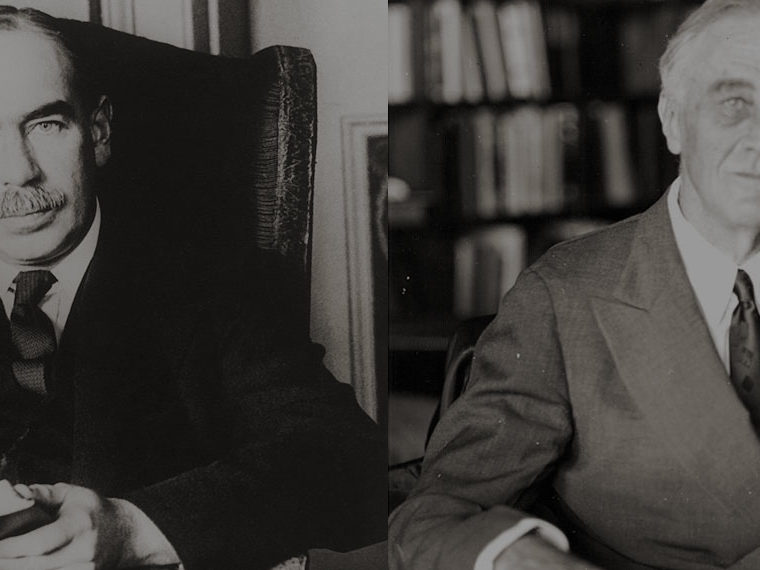A tool in the debate over shareholder primacy and wealth disparities
Milton Friedman would have been horrified.
Fifty years ago, the famed University of Chicago economist laid down what he considered one of the immutable laws of corporate governance: Management’s job was to “make as much money as possible” for shareholders — period. The idea that a business should also be run for and by other “stakeholders” (such as employees or society at large) was heresy to Friedman.
In a provocative New York Times Magazine essay published in 1970, he wrote that business executives who countenanced using company assets for something other than shareholder enrichment were “preaching pure and unadulterated socialism.”
Opt In to the Review Monthly Email Update.
Fast-forward to August 2019. The Business Roundtable, a 47-year-old association of CEOs of America’s biggest companies, announced that it was jettisoning its core governance philosophy of “shareholder primacy.” The group’s original guiding tenet that “corporations exist principally to serve shareholders” was replaced with a commitment to managing companies “for the benefit of all stakeholders: customers, employees, suppliers, communities and shareholders.”
The roundtable’s decision was echoed a few months later at the World Economic Forum in Davos, Switzerland. The 2020 theme of the annual gathering of the planet’s rich and powerful: “Stakeholders for a Cohesive and Sustainable World.”
It would be easy to dismiss this seemingly sudden embrace of “stakeholder capitalism” as largely fear-motivated, an attempt by the corporate elite to appease governments, workers and consumers amid heated global discussions over income and wealth inequality, climate change and other critical issues.
In recent years the inequality debate frequently has centered on a single number: the share of U.S. national income that flows to workers as the reward for their labor. That share fell from 66% after World War II to a historic low of 56% by 2010, and has since stabilized near that level. As labor’s share of income declined, the share flowing to the owners of business capital (for example, shareholders) has risen. The theories behind this monumental income shift have generated reams of academic research.
The issue often is framed as if corporate executives can merely throttle back on profit-seeking or, in the alternative, squeeze their operations for every last dime to hand to shareholders. But the other constituencies (especially employees, customers and suppliers) aren’t entirely without leverage. And when a company is creating value, those non-shareholder groups are angling for returns, too. Yet the more nuanced shifts in wealth have been hard to measure — a source of frustration to academics, including UCLA Anderson’s Marvin B. Lieberman.
The concept of business value creation has been a research interest of Lieberman’s since he was in graduate school at Harvard. He remembers a Harvard professor’s study of Levitz Furniture, a star retail chain of the 1960s, and how the company was said to have created and then destroyed shareholder value. “I was puzzled by the latter,” Lieberman said in an interview.
The Harvard professor equated shareholder loss with the destruction of value, it seems. But Lieberman was mulling a broader notion of value. Furniture chains compete on price and often operate with thin, and at times negative, margins. Selling a lot of furniture at a loss certainly can destroy investor (shareholder) value if the company exhausts its cash reserves and ultimately fails. But the buyers of couches at ultra-cheap prices captured value. For a time, employees and suppliers did, too.
“I realized that the value did not disappear; it shifted to other stakeholders, such as customers, where it could not be so easily measured,” Lieberman said.
With that broader idea about value, Lieberman took on the measurement challenge in a study with colleagues Roberto Garcia-Castro of the IESE Business School in Madrid and Natarajan Balasubramanian of Syracuse University. In a paper published in the Strategic Management Journal, they introduced what they called the VCA model, for “value creation and appropriation among firms.”
The model’s math is relatively straightforward. “The lynchpin of this approach is a simple accounting identity that equates the revenues of a firm to the sum of all payments made to its stakeholders” over time, the authors write. They count four major stakeholder groups: customers, employees, suppliers and investors.
The term value creation is synonymous with economic gain. “From one period to the next, a firm creates value or achieves an economic gain for its stakeholders if it produces more output quantity or better output quality (as reflected by a higher customer willingness to pay) using the same amount of resource inputs,” the paper says. To put it another way, true value isn’t generated by business as usual. Rather, it’s created when a company operates more efficiently, increases productivity or simply comes up with a better product.
“The VCA model at its core is a productivity framework,” Lieberman said in the interview. “Any long-term rise in living standards is ultimately the result of productivity gains, which stem from innovations of many kinds.”
For the study, the authors applied their model to two industries — airlines and automakers — which they chose because of the sectors’ economic importance and the ready availability of data on the businesses. The goal was to measure the change in value creation among major companies in the two industries and how it was distributed over time among the companies’ stakeholder groups.
What might have shocked Friedman was how little of that newly created value went to the investor stakeholder group. Both airlines and autos, of course, are heavily unionized (a key structure for employees trying to capture value), and when the companies ran into trouble, adjusting worker compensation downward was very difficult, at times only achieved through bankruptcy filings.
“In both industries, our analyses strongly suggest that shareholders capture only a small fraction of the value created by a firm, with other stakeholders capturing most of the gains,” the paper says. “Indeed, our estimates indicate that in many cases these other stakeholders were able to appropriate all of the gain at the expense of shareholders.”
In the case of the airline industry, the authors calculated the change in economic gains generated by seven major U.S. carriers over three decades: the 1980s, 1990s and 2000–2010. Those seven carriers included the current Big Four of American, Delta, Southwest and United, as well as Alaska, Continental (which later merged with United) and US Airways (which later joined with American).
The 1980s were a financial disaster for the major carriers, as federal deregulation of the industry in 1978 produced a slew of new rivals. The total net change in economic gain generated by the seven big carriers was just 8% in the 1980s, the study says.
But it was a great decade to be a passenger, as competition ballooned and fares fell. The airlines’ customer stakeholder group captured an 18% average economic gain over the 10 years. Passengers also reaped a 19.5% average economic gain in the 1990s and 16.9% in the 2000s decade. “Customers benefited from intense industry rivalry and persistent excess capacity, which provoked substantial price cuts over the three decades,” the study says.
Another big airline stakeholder beneficiary in the 2000s decade: fuel suppliers, which realized a 15.7% change in economic gain from the carriers as rebounding oil prices forced airlines to pay up.
Overall, the authors’ estimates of value created by the airline industry over the three decades implies that 83% of the incremental value gain went to customers, 7% to employees, 4% to fuel suppliers and 6% to other suppliers. That left less than 1% of the economic gain for shareholders and other capital providers.
Airlines may be an extreme example of poor shareholder returns in recent decades, but the industry also powerfully illustrates a central point of Lieberman’s VCA analysis, which is that “most economic value flows to consumers,” he said in an interview. “Basically, the process of competition ensures that consumers capture most of the gain. So, in most industries, it is true that the economic gains flowing to customers are much greater than the gains flowing to shareholders.”
In the paper, the authors also applied their VCA model to three titans of the global auto industry: General Motors, Nissan and Toyota. They studied the companies over two time periods, 1978–1988 and 1988–1998. Three of the stakeholder groups they tracked — customers, employees and shareholders — were the same as those in the airline study. But in place of suppliers the authors added government to the auto study.
GM’s shareholders suffered mightily: After-tax gains captured by investors fell by 10% in the first 10-year period and 30% in the second. But, as with airlines, GM’s customer stakeholders were winners, benefiting from a decline in the real (after inflation) price of GM vehicles. “Another beneficiary group consisted of the employees of GM, who gained through higher wages and benefits,” the study says. “The gains to workers at GM over the 1988–1998 period were more than twice as large as those shown for employees of the two Japanese automakers.”
In the 1978–1988 period, one of the biggest stakeholder beneficiaries among the three companies was the Japanese government, owing to the massive taxes Toyota paid on profits it reaped.
Friedman certainly understood that employees, suppliers, customers, governments and even society as a whole had vested interests in corporate success. But that didn’t stop him from taking a hard line in his 1970 essay, declaring that any executive who preached “social responsibility” was in effect saying “that he is to act in some way that is not in the interest of his employers” (the shareholders).
Lieberman doesn’t hesitate in arguing against Friedman’s absolutist stance. “Clearly, a certain amount of spending on social goals, such as a match of employee charitable contributions, can maximize profits even in the short run by helping to attract, motivate and retain good employees, and by maintaining good community and customer relations,” Lieberman said in the interview. “So I think the statement by Friedman is definitely wrong in a strict sense.”
What’s more, Lieberman notes that the idea of “shareholder primacy” has “largely been an American perspective. There are many other countries, such as Germany and Japan, where a broader stakeholder perspective has long been dominant.”
But shareholder-primacy advocates can point out that U.S. stocks have dramatically outperformed European and Japanese stocks since 1990 — the reward, perhaps, for American companies that have stuck with a highly shareholder-focused approach to business.
Despite the Business Roundtable and Davos declarations, some academics are skeptical that an enhanced commitment to “stakeholder capitalism” is about to sweep U.S. corporate boardrooms. Brian Cheffins, a law professor at the University of Cambridge, believes it’s “open to question whether a major shift in corporate priorities beckons, given that the most potent managerial incentives — pay and job security — remain tied to stock performance.”
Airlines in recent years veered strongly toward rewarding shareholders, distributing nearly all their free cash flow in the form of stock buybacks, and also paying out enormous dividends. When the COVID-19 pandemic hit, that left them with little cash cushion to get through a downturn, and they sought and won a government bailout.
Lieberman says his goal with the VCA model isn’t to suggest that companies are wrong to focus on shareholder enrichment, but to show that there are different roads to that end.
“I think that managers do need to focus on shareholder value,” he said in the interview. “The big issue is the extent to which sharing the gains in the short run expands the pie for everyone, including shareholders, in the long run.”
“Our approach is agnostic,” he said, meaning it doesn’t take a stand on how best to create value. “The VCA model itself is purely descriptive and focuses solely on measurement. However, it has the benefit of making people think through the big questions: How much gain is created overall, and how is it distributed? If you focus only on shareholder value, you lose the big picture.”
Featured Faculty
-
Marvin Lieberman
Harry and Elsa Kunin Chair in Business and Society; Professor of Strategy
About the Research
Lieberman, M.L., Garcia-Castro, R., & Balasubramanian, N. (2017). Measuring value creation and appropriation in firms: The VCA model. Strategic Management Journal, 38(6), 1193–1211. doi: 10.1002/smj.2565






